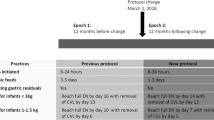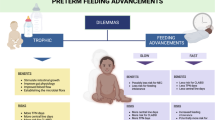Abstract
Extremely low birth weight infants may experience periods of moderate to severe undernutrition during the acute phase of their respiratory problems. This undernutrition contributes to early growth deficits in these patients and may have long-lasting effects, including poor neurodevelopmental outcome. Early postnatal intravenous amino-acid administration and early enteral feeding strategies will minimize the interruption of nutrient intake that occurs with premature birth. These two strategies will prevent intracellular energy failure, allow the administration of more non-protein energy, as well as enhance overall nutritional health, as evidenced by less postnatal weight loss and earlier return to birth weight, and improved overall postnatal growth and outcome.
This is a preview of subscription content, access via your institution
Access options
Subscribe to this journal
Receive 12 print issues and online access
$259.00 per year
only $21.58 per issue
Buy this article
- Purchase on Springer Link
- Instant access to full article PDF
Prices may be subject to local taxes which are calculated during checkout

Similar content being viewed by others
References
Ehrenkranz RA, Younes N, Lemons JA, et al. Longitudinal growth of hospitalized very-low-birth-weight infants. Pediatrics 1999;104:280–289.
Carlson SJ, Ziegler EE . Nutrient intakes and growth of very-low-birth-weight infants. J Perinatol 1998;18:252–258.
Embleton NE, Pang N, Cooke RJ . Postnatal malnutrition and growth retardation: an inevitable consequence of current recommendations in preterm infants? Pediatrics 2001;107:270–273.
Hay Jr WW, Lucas A, Heird WC, et al. Workshop summary: nutrition of the extremely-low-birth-weight infant. Pediatrics 1999;104:1360–1368.
Frantz ID, L'Heureux P, Engel RR . Necrotizing enterocolitis. J Pediatr 1975;86:259.
Kliegman RM, Fanaroff AA . Neonatal necrotizing enterocolitis: a nine-year experience. Am J Dis Child 1981;135:603–607.
Johnson JD, Albritton WL, Sunshine P . Hyperammonemia accompanying parenteral nutrition in newborn infants. J Pediatr 1972;81 (1):154–161.
Kashyap S, Heird W . Protein requirements of low-birth-weight, very-low birth-weight, and small-for-gestational-age infants. In: Raiha N, editor. Protein Metabolism During Infancy. New York: Raven Press; 1993. p. 133–151.
Rubecz I, Mestyan J, Varga P, Klujber L . Energy metabolism, substrate utilization, and nitrogen balance in parenterally fed postoperative neonates and infants. The effect of glucose, glucose + amino acids, lipid + amino acids infused in isocaloric amounts. J Pediatr 1981;98 (1):42–46.
Zlotkin SH, Bryan MH, Anderson GH . Intravenous nitrogen and energy intakes required to duplicate in utero nitrogen accretion in prematurely born human infants. J Pediatr 1981;99 (1):115–120.
Duffy B, Gunn T, Collinge J, Pencharz P . The effect of varying protein quality and energy intake on the nitrogen metabolism of parenterally-fed very- low-birth-weight (less than 1600 g) infants. Pediatr Res 1981;15 (7):1040–1044.
Van Toledo-Eppinga L, Kalhan SC, Kulik W, Jakobs C, Lafeber HN . Relative kinetics of phenylalanine and leucine in low-birth-weight infants during nutrient administration. Pediatr Res 1996;40 (1):41–46.
Anderson TL, Muttart CR, Bieber MA, Nicholson JF, Heird WC . A controlled trial of glucose versus glucose and amino acids in premature infants. J Pediatr 1979;94 (6):947–951.
Yu VY, James B, Hendry P, MacMahon RA . Total parenteral nutrition in very-low-birth-weight infants: a controlled trial. Arch Dis Child 1979;54 (9):653–661.
Saini J, MacMahon P, Morgan JB, Kovar IZ . Early parenteral feeding of amino acids. Arch Dis Child 1989;64 (10 Spec No):1362–1366.
Van Lingen RA, Van Goudoever JB, Luijendijk IH, Wattimena JL, Sauer PJ . Effects of early amino acid administration during total parenteral nutrition on protein metabolism in pre-term infants. Clin Sci (Lond) 1982;82 (2):199–203.
Van Goudoever JB, Colen T, Wattimena JL, Huijmans JG, Carnielli VP, Sauer PJ . Immediate commencement of amino acid supplementation in preterm infants: effects on serum amino acid concentrations and protein kinetics on the first day of life. J Pediatr 1995;127 (3):458–465.
Thureen PJ, Anderson AH, Baron KA, Melara DL, Hay Jr WW, Frennessey PV . Protein balance in the first week of life in ventilated neonates receiving parenteral nutrition. Am J Clin Nutr 1998;68 (5):1128–1135.
Rivera Jr A, Bell EF, Bier DM . Effect of intravenous amino acids on protein metabolism of preterm infants during the first three days of life. Pediatr Res 1993;33 (2):106–111.
Thureen PJ, Hay WW . Intravenous nutrition and postnatal growth of the micro preemie. Clin Perinatal 2000;27 (1):225–244.
Heird WC, Jensen CL, Gomez MR . Practical aspects of achieving positive energy balance in low-birth-weight infants. J Pediatr 1992;120:120–128.
Lucas A . Minimal enteral feeding. Seminars in neonatal nutrition and metabolism. 1993;1:2.
Dworkin LD, Levine GM, Farber NJ, et al. Small intestinal mass of the rat is partially determined by indiscrete effects intraluminal nutrition. Gastroenterology 1976;71:626–630.
Levine GM, Deren JJ, Steiger E, Zinner R . Role of oral intake in maintenance of gut mass and disaccharide activity. Gastroenterology 1974;67:975–982.
Lucas A, Bloom SR, Aynsley-Green A . Gut hormones and “minimal enteral feeding”. Acta Pediatr Scand 1986;75:719–723.
Kliegman RM . Experimental validation of neonatal feeding practices. Pediatrics 1999;103:492–493.
Ziegler EE . Trophic Feeds. In: Ziegler EE, Lucas A, Moro GE, editors. Nutrition of the Very-Low-Birth-Weight Infant. Vevey: Lippincott Williams and Wilkins;1999. p. 233–244.
Mihatsch WA, von Schoenaich P, Fahnenstich H, Dehne N, Ebbecke H, Plath C . The significance of gastric residuals in the early enteral feeding advancement of extremely-low-birth-weight infants. Pediatrics 2002;109:457–459.
Kleigman RM . Commentary studies of feeding intolerance in very-low-birth-weight infants: definitive and significance. Pediatrics 2002;109 (3):671–672.
Brown EG, Sweet AY . Preventing necrotizing enterocolitis in neonates. JAMA 1978;240:2452–2454.
Tyson JE, Kennedy K . Minimal enteral nutrition in parenterally fed neonates. 1997. Available at: http://www.nichd.nih.gov/cochraneneonatal/tyson/tyson/htm.
McClure RJ, Newell SJ . Randomized control study of clinical outcome following trophic feeding. Arch Dis Child Fetal Neonatal Ed 2000;82:F29–F33.
Anderson DM, Kliegman RM . The relationship of neonatal alimentation practices to the occurrence of endemic necrotizing enterocolitis. Am J Perinatol 1991;8:62–67.
Rayyis SF, Ambalavanan N, Wright L, Carlo WA . Randomized trial of “slow” versus “fast” feed advancements on the incidence of necrotizing enterocolitis in very-low-birth-weight infants. J Pediatr 1999;134:293–297.
Caeton AJ, Goetzman BW . Risk business, umbilical arterial catheterization. Am J Dis Child 1985;139:120.
Davey AM, Wagner CL, Phelps DL, et al. Do premature infants with umbilical artery catheters tolerate oral feeds? Pediatr Res 199A;31:199A.
Kerner JA . The use of umbilical catheters for parenteral nutrition. In: Kerner JA editor. Manual of Pediatric Parenteral Nutrition. New York: John Wiley & Sons; 1993. p. 303.
Wesstrom G, Finnstrom O, Stenport G . Umbilical artery catheterization in newborns: I. Thrombosis in relation to catheter type and position. Acta Pediatr Scand 1979;68:575.
Lucas A, Cole TJ . Breast milk and neonatal necrotizing enterocolitis. Lancet 1990;336:1519–1523.
Berseth CL, Bisquera JA, Page U . Prolonging small feeding volumes early in life decreases incidence of NEC in very-low-birth-weight infants. Pediatrics 2003;111 (3):529–533.
Author information
Authors and Affiliations
Additional information
Disclosure: No significant relationship to disclose.
Rights and permissions
About this article
Cite this article
Adamkin, D. Pragmatic Approach to In-Hospital Nutrition in High-Risk Neonates. J Perinatol 25 (Suppl 2), S7–S11 (2005). https://doi.org/10.1038/sj.jp.7211309
Published:
Issue Date:
DOI: https://doi.org/10.1038/sj.jp.7211309
This article is cited by
-
A longitudinal evaluation of growth outcomes at hospital discharge of very-low-birth-weight preterm infants
European Journal of Clinical Nutrition (2012)
-
Iatrogenic complications in the neonatal intensive care unit
Journal of Perinatology (2010)
-
Outcomes of early parenteral nutrition for premature infants
Journal of Perinatology (2010)
-
To tube or not to tube babies with respiratory distress syndrome
Journal of Perinatology (2009)
-
Pattern of daily weights among low birth weight neonates in the neonatal intensive care unit: data from a multihospital health-care system
Journal of Perinatology (2006)



